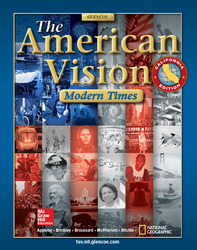

The American Vision: Modern Times, California EditionChapter 1: Creating a NationChapter OverviewThis chapter explores the events that brought the cultures of Europe and Africa to the Americas and details the birth of a new nation. 1.1 Converging Cultures Section 1 explores how societies in North America have changed over time and how European colonies developed. Thousands of years before Christopher Columbus and other European explorers set foot in America, Native Americans began planting and raising crops. By the time of Columbus began his voyages in the late fifteenth century, a wide range of civilizations and languages existed in North America. Once explorers learned that Columbus had reached new lands, other European explorations began to search for new territory. New settlers looked to enslaved Africans to help farm. The harsh treatment of the Africans was a sharp contrast to the lives of the privileged. While enslaved Africans came to the new world against their wills, people seeking religious and economic relief flooded the Americas by the thousands. 1.2 Dissent and Independence Section 2 examines the relationship between the colonists and the crown, leading to the colonists' eventual independence. English Parliament passed Navigation Acts preventing colonists from trading goods with any country other than England. During that time, America saw the emergence of the Enlightenment and the Great Awakening. Great Britain faced steep debts after its victory in the French and Indian War, and many leaders believed that the colonists should share in the burden of repaying those debts. Imposed taxes outraged colonists, and they declared their independence from England. Outnumbered in size, funding, and discipline, the Continental Army faced a daunting task, but victory was finally realized after winning the last major battle in Yorktown, Virginia in the fall of 1781. 1.3 The Constitution Section 3 describes the Constitution. The Framers crafted a living document that included a system to allow the Constitution to be amended. The Constitution provided for a separation of federal power among the three branches of government-executive, legislative, and judicial-and created a system of checks and balances. The Bill of Rights was devised to protect individual freedoms. In return for their citizenship, citizens are expected to perform certain duties and to fulfill certain responsibilities. |  |















